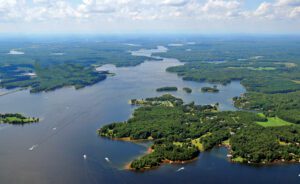From Spring through Winter, Lake Anna Offers Fishing for Every Season
By Chris Craft. Images from Chris Craft
Most anglers refer to the different sides of Lake Anna as the “hot side” and the “cold side.” Although there are fishing opportunities on the hot side, you must have access to one of the private ramps located on that side. The cold side, however, has several public ramps that can be used 365 days per year. There are several different species of fish that anglers can pursue on Lake Anna, with the top three being Largemouth Bass, Crappie and Striper.
Largemouth Bass
The Largemouth Bass gets the most attention; many anglers visit Lake Anna in March and April looking for that bass of a lifetime. Lake Anna does not have a minimum size requirement to keep a bass; most anglers practice catch and release, as they are a popular tournament fish. If you do keep some, the creel limit is five per day, per angler. A trophy fish by Virginia guidelines is a fish that weighs eight pounds and/or measures 22 inches in length. The lake record was caught on March 20, 1985, and my personal best weighing in at nine pounds, one ounce was caught on March 13, 2012. So, it can be said that the best time to catch a true giant largemouth from Lake Anna is during March.
There are many ways to catch bass as they move from their winter hideouts. In early March, when the water first starts to warm up, they will slowly start making a move to shallower water. Keep in mind that deep water nearby is a must. My best overall bait this time of year is a suspending jerkbait.
As we move toward the end of the month, and the water warms even more, the bass will become more aggressive. You can now fish your suspending jerkbaits much faster and even move on to other baits such as spinnerbaits, squarebill crankbaits and soft jerkbaits.
As the full moon in April approaches, the bass start feeding heavy in preparation for the upcoming spawn. They will take a variety of baits and be very aggressive doing so. This is a great time to put your top water lures to work. Large walking baits, poppers and buzzbaits are all great choices for this task, as they will all draw explosive and violent strikes.
Now we are moving into summer patterns. The fish will start to pull out of the shallows and move out with the increasing boat traffic and warmer water temperatures. Deeper brush piles, rock piles, boat docks and bridge pilings will all hold numbers of fish in the summertime.
They will stay in these areas all summer long until the water temperature starts to drop back off in the fall—usually by mid-October they are shallow again, as this is the beginning of the fall feeding frenzy. Small crankbaits, spinnerbaits, lipless crankbaits, hard jerkbaits and soft jerkbaits are all great bait fish imitators and will catch fish for you.
As the winter months close in, those anglers brave enough to outlast the elements can be rewarded with giant bass and heavy bags to bring onto the scales. Vertical jigging is one of the best ways to catch them at this time of year. Learning your electronic devices is a must for this type of fishing.

Crappie
The Black Crappie, also known as specks, freckles and silver perch, comes in a close second to the Largemouth Bass for Lake Anna anglers. These tasty panfish are hearty fighters and plentiful throughout Lake Anna—though up lake has better fishing than down lake. For a crappie to be considered a trophy in Virginia, they must be either two pounds or 15 inches. Though there is no minimum size on crappie in Lake Anna, there is a 25 fish per day, per angler creel limit.
Once March rolls around, the crappie start making their move toward the shallows; usually they are the first fish to spawn in the spring. Crappies are very aggressive throughout the spawn and will take a variety of artificial baits and colors as well as minnows. Many anglers use small minnows rigged under a slip bobber to catch them; I, on the other hand, prefer to employ two-inch curly tail grubs rigged on a one-sixteenth ounce jig head.

After the spawn is over in mid-May, they will start retreating back to deeper water for the summer months; I usually leave them alone for this period of time.
During summer, they’re around deep boat docks, deep bridge pilings, deep rock piles and some will just suspend over deep water. The most popular place to catch them during the summer is around the many bridge pilings throughout the lake. A small minnow on a one-sixteenth or one-eighth-ounce jighead will produce the best results.
The most important part of crappie fishing is the rod, reel and line. To thoroughly enjoy crappie fishing, a lite or ultra lite rod is a must. A six-pound test line is really about as heavy as you will want to use. The best part about crappie fishing is that these are great angling fish for kids.
As summer ends and fall begins, they will start to follow bait balls into the creeks, and they will set up an ambush around the many boat docks. A little more skill is involved in fall crappie fishing; they will set up as far as they can under boat docks, and skipping or shooting your grub is a must. If the water level in the lake is down about a foot, it makes it much easier to get your bait to the fish.
Fall is now over and wintertime is setting in. The water temperature is now in the low 40s and the fish have pulled out of the shallows. Some fish will relocate to deep brush piles and back to the bridge pilings, but most will just suspend over deep water and follow the bait balls around.
Striped Bass
The Striped Bass, or striper, fishing on Lake Anna has gotten better over the past several years and many more anglers are pursuing them. Though we do not see many trophy-class fish caught, we do see many in the 10-pound-plus range, but most are an average of five to seven pounds. For a landlocked, fresh water striper to be considered a trophy in Virginia, they have to be at least 20 pounds or 37 inches. In order to keep a striper on Lake Anna, the minimum length has to be 20 inches, and the creel limit is four per day, per angler.
There are several ways to catch them, such as trolling, live bait, vertical jigging and casting artificial lures to them. If you plan on using live bait, plan on getting out of bed very early and trying your luck at attracting bait to a light hung under a bridge and throwing a net on them. Native bait—Gizzard Shad or Blue Back Herring—is by far the best.
In March, you can find me chasing striper up in the two river arms of the lake. They are usually feeding heavy on small black crappie at this time of year, so my bait of choice is a suspending jerkbait that I have painted in a color we call “tuxedo purple.”
As April rolls around, you can locate the schools of fish up lake in shallow water. Try casting a broken back redfin to them, and be sure to fish the bait all the way back to the boat.
Summertime striper fishing can be really great at first light; the fish will be aggressively chasing bait in the mid-lake area until the sun gets high enough to penetrate the water. Once the sun is up and the feed is over, you can still catch them by using your electronics to locate the deep schools. Another popular way to catch summertime striper is by trolling artificial lures. Deep diving redfins with a bucktail trailer seem to be the most popular.
As we head into fall, the striper will begin to follow the bait movement up lake where you can use birds to give away the location of the schools. Cast a minimum of 100 yards from them while you move into position with your trolling motor. A four-inch paddle tail swimbait rigged on a one-fourth-ounce jig head is my all-time favorite lure. A sensitive rod is a must for this; most of the strikes will be very subtle and a too heavy of a rod will hide these strikes from you.
You can chase striper like this all the way through the winter as well. Once the water temperatures drop below 40 degrees, the bite will be very slow; that is, if they are feeding at all.
Another species to stretch your fishing line is the “wiper”, this fish is a hybrid between a Striped Bass and a White Bass. They are strong and plentiful, but like the striper they must be 20 inches long to keep. The daily creel limit is four per person per day, this is combined with the striper.





















